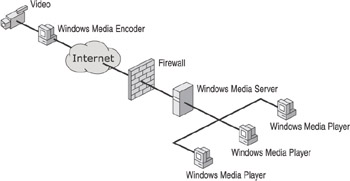Chapter 3: Distributing Content with Windows Media Services
Windows Media Services 9 Series is the distribution component of the Windows Media 9 Series platform. It is a streaming media server that works in conjunction with Windows Media Encoder and Windows Media Player to deliver live or on-demand audio and video content to clients over an intranet or the Internet. The clients might be other computers or devices that play back the content using a player, such as Windows Media Player, or they might be other computers running Windows Media Services (called Windows Media servers) that are proxying, caching, or redistributing your content. Clients can also be custom applications that have been developed using the Windows Media Format Software Development Kit (SDK).
Content Distribution Methods
Windows Media Services can deliver a live stream, such as a broadcast of a live event, or existing content, such as a digital media file. In the case of live content, Windows Media Services gets the stream from Windows Media Encoder before sending it on to clients. There are two ways in which this can be done: push distribution and pull distribution.
In the push method of distribution (which is a new addition to Windows Media 9 Series), the encoder initiates contact with the Windows Media server and then pushes the live content to a broadcast publishing point on that server.
In pull distribution, the Windows Media server or Windows Media Player contacts the encoder to request or pull the stream. While both options ultimately deliver live content to Windows Media Player, each is designed for a different scenario.
Push Distribution
Pushing a stream from the encoder is ideal when the encoder is behind a firewall. Some firewalls don’t support connections that are initiated externally, so push distribution enables the encoder administrator to control the broadcast directly from the encoder.
For example, say you have just received last-minute notice that the president of your company wants to deliver important information to company employees in a live address. The Windows Media server is located outside your company firewall and the server administrator is not currently available. You, as the encoder administrator, have administrative rights on the Windows Media server and can configure the encoding session, set up a broadcast publishing point on the Windows Media server, and start the broadcast without ever leaving the Windows Media Encoder user interface. The stream is pushed through the firewall using HTTP, as shown in figure 3.1.

Figure 3.1: The encoder pushes the stream to a Windows Media server.
Using push distribution is also a good idea when you are initiating a broadcast to a server that is controlled by a third party, such as a content delivery network (CDN). In this case, you might have breaking news that you need to broadcast right away. Using push, you can initiate the stream when it’s necessary to do so without having to locate the server administrator in order to start the stream.
Pull Distribution
Pulling a stream from an encoder is useful in several scenarios. First, if there are multiple distribution servers, all connecting at different times, each server can initiate the connection with the encoder when it is ready to stream. Next, pulling from a server is useful if it is important to minimize bandwidth usage between the server and the encoder. For example, the server administrator can add a publishing point and configure it to start automatically, which means that the server does not initiate the connection with the encoder until the first client connects. This eliminates unnecessary bandwidth use between the server and the encoder.
Pulling from the server is also useful when the server is behind a firewall. For example, you might set up the encoder on a public network because you are streaming events at a conference. You need to get the stream to a distribution server inside the protected network so it can be delivered to clients on the corporate LAN. In this case, the server administrator can pull the stream from the encoder through the firewall using HTTP, as shown in figure 3.2.

Figure 3.2: Windows Media Services pulls the stream from Windows Media Encoder.
Finally, pulling from the encoder is necessary when you want to authorize clients to connect directly to the encoder to receive the stream, as shown in figure 3.3. Windows Media Encoder supports up to five concurrent connections. When you are enabling clients to pull the stream, you can restrict access to specific IP addresses or to groups of IP addresses.

Figure 3.3: Client computers pull the stream directly from the encoder
EAN: 2147483647
Pages: 258